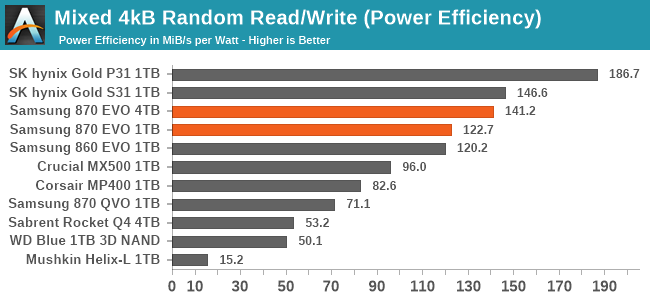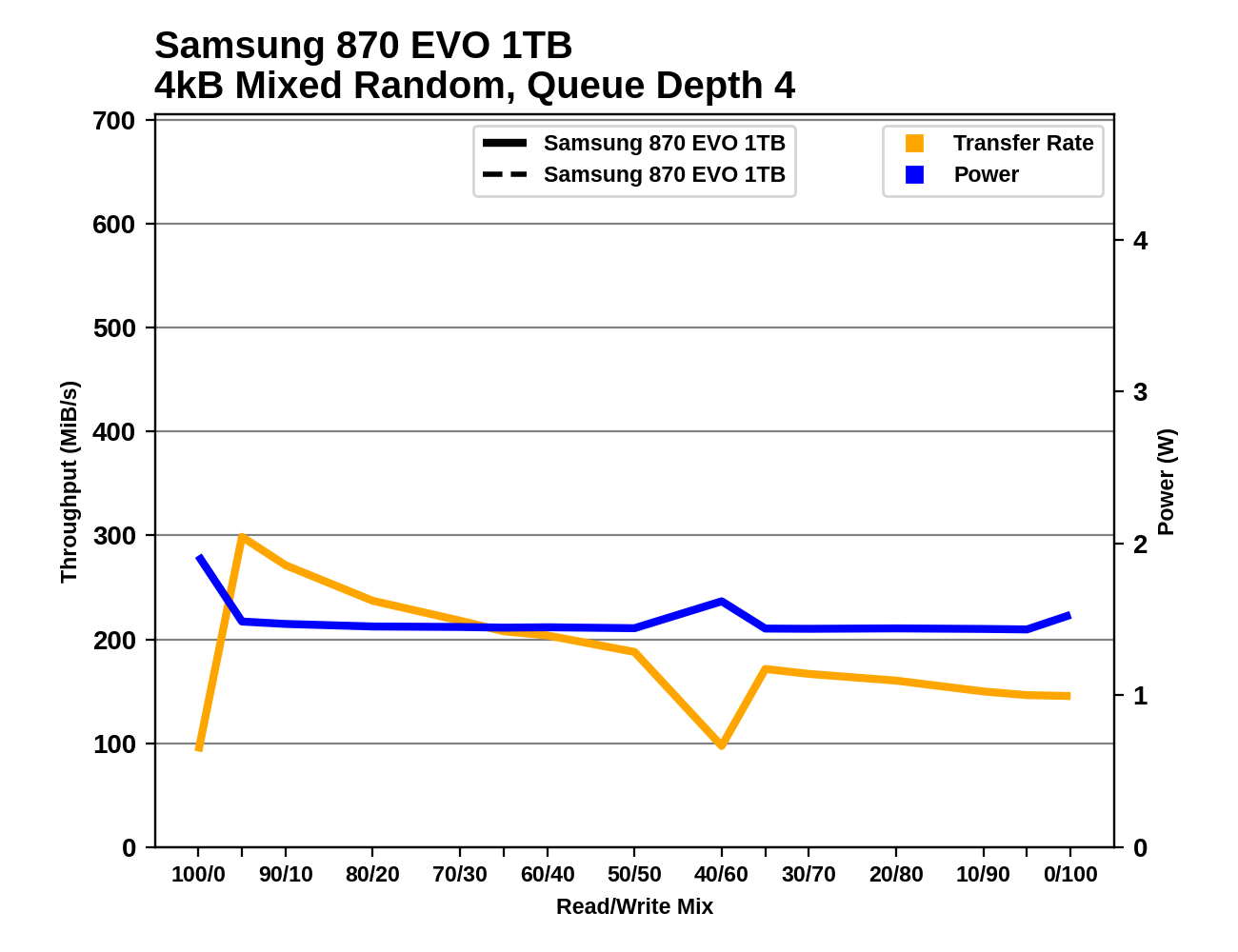The Samsung 870 EVO (1TB & 4TB) Review: Does the World Need Premium SATA SSDs?
by Billy Tallis on February 17, 2021 8:00 AM ESTMixed IO Performance
For details on our mixed IO tests, please see the overview of our 2021 Consumer SSD Benchmark Suite.
 |
|||||||||
| Mixed Random IO | Mixed Sequential IO | ||||||||
The mixed random IO test provides the Samsung 870 EVO with one of its biggest performance wins yet over the rest of the SATA field and the entry-level NVMe competition. But most of that comes from the capacity advantage the 4TB model has over most of these comparison drives; the 1TB 870 EVO is only about 5% faster overall than the 860 EVO. On the mixed sequential IO test, the SATA bottleneck keeps most of the performance scores within a fairly narrow range, and the 1TB 870 EVO's performance is actually a bit of a regression compared to its predecessor.
 |
|||||||||
| Mixed Random IO | Mixed Sequential IO | ||||||||
As with our separate tests of random reads and writes, the top efficiency scores for mixed random IO go to SK hynix, with Samsung's TLC drives turning in the next best scores and having a clear advantage over other competing brands. Over on the sequential IO side of things, the efficiency scores more closely mirror the performance scores, and the 870 EVO doesn't have any real advantage over other mainstream SATA drives.
 |
|||||||||
| Mixed Random IO | |||||||||
| Mixed Sequential IO | |||||||||
The 1TB 870 EVO's performance during the mixed random IO test is more consistent than the 860 EVO's, but still has a few unpleasant drops that aren't present for the 4TB model. On the mixed sequential IO test, the 1TB 870 EVO's performance is actually a bit less consistent than the 860 EVO. But aside from those occasional outliers, the general trend is for the 870 EVO to provide superior random IO performance and link-saturating sequential performance across a wide range of workload mixes.
Idle Power Management
Real-world client storage workloads leave SSDs idle most of the time, so the active power measurements presented earlier in this review only account for a small part of what determines a drive's suitability for battery-powered use. Especially under light use, the power efficiency of a SSD is determined mostly be how well it can save power when idle.
SATA SSDs are tested with SATA link power management disabled to measure their active idle power draw, and with it enabled for the deeper idle power consumption score and the idle wake-up latency test. Our testbed, like any ordinary desktop system, cannot trigger the deepest DevSleep idle state. For more details, please see the overview of our 2021 Consumer SSD Benchmark Suite.


The Samsung 870 EVO may feature an updated controller compared to the 860 EVO, but there's no real difference in idle power consumption, for either active idle or the desktop (non-DevSleep) idle states. Samsung's idle power figures are best in class, with SK hynix offering the only close competition.

The Samsung SATA drives all take about one millisecond to wake up from using SATA link power management. This is higher than several of the other SATA drives, but not really enough to be of much concern for system responsiveness.










136 Comments
View All Comments
Glaurung - Wednesday, February 17, 2021 - link
The main barrier for the formal death of SATA are hundreds of millions of perfectly usable older systems that don't support NVME or have limited NVME slots.Qasar - Wednesday, February 17, 2021 - link
" Main barrier for the formal death of SATA is still cost as NVMe still carries a slight premium over SATA and consumer systems have limited PCIe connectivity. "i think you might be also forgetting the aspect of the space requirements of the nvme connector as well.
Lord of the Bored - Wednesday, February 17, 2021 - link
I've always thought SATA was a mistake.Removing the ability to chain multiple drives made for an ugly cabling situation, and the connectors are flimsy as hell. The new power connector in particular served no purpose whatsoever aside from annoyance.
If it had used more robust connectors and allowed chaining drives, it would've been fantastic. But that would've been to much like the right decision for them to entertain it.
Glaurung - Wednesday, February 17, 2021 - link
SATA on the desktop and in NAS boxes is still very much alive, TYVM.Sata SSDs will continue to be made and sold as long as there are older computers in use that have a SATA bay in them. My main computer only has 1 NVME slot, but it also has a SATA bay. WIthout that SATA bay I'd have to have all my files crammed onto on a single SSD.
Kamen Rider Blade - Wednesday, February 17, 2021 - link
The technology to update SATA is there, it just takes a bit of will power from the SATA group to borrow the SAS speeds and bring it to the consumers.The SATA connector is far better suited for "Hot Swap" and M.2 was never designed for "Hot Swap" capabilities.
powerarmour - Wednesday, February 17, 2021 - link
No, we'll require SATA for bulk storage for a good few years yet.How many M.2 only NAS systems are there?
CaedenV - Wednesday, February 17, 2021 - link
SATA is still perfectly fine for old spinning rust drives. Sure the burst performance could be better with a faster connection... but how often is that needed? For sustained data transfers SATA3 is still faster than any spinning drives on the market that cap out at 150-200MBps on a good day.watzupken - Wednesday, February 17, 2021 - link
I don't think SATA is going to go away anytime soon. While it is not as fast as a good NVME SSD, it makes up for it by offering a good price to capacity ratio. It just like why mechanical drive still exists today. Most NVME SSDs are affordable up to around 1TB, and at higher capacity, the prices goes up significantly. Also one is usually limited to 2 or 3 NVME slots due to limitation of number of PCI-E lanes. Thus, having the SATA ports to supplement additional storage is unlikely to go away, at least from a desktop perspective.sonny73n - Thursday, February 18, 2021 - link
"..,Most NVME SSDs are affordable up to around 1TB, and at higher capacity, the prices goes up significantly."Please stop spouting BS.
ADATA SX8200 Pro 2TB M.2 $239
Samsung 870 EVO 2TB SATA $249
Both is on Amazon right now.
Oxford Guy - Friday, February 19, 2021 - link
2TB on black Friday for an ADATA over a year ago. $250 isn't impressive.